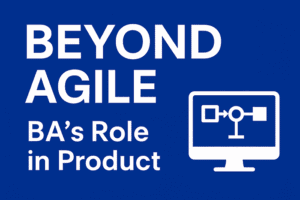
Are you a Business Analyst feeling stuck in the “Agile” way of working? What if your real potential is bigger than just user stories and sprint planning? Today‘s fast–moving digital world needs more than just organizing a backlog—it needs people who can create real value through smart product thinking.
Let’s look at how Business Analysts are stepping out of the Agile box and becoming important players in shaping product strategy, driving innovation, and helping businesses succeed long–term.
The Changing World of Product Development
Agile methods like Scrum and Kanban have changed how teams build and deliver value—faster releases, constant feedback, and stronger teamwork.
But as products get more complex, teams need more than just fast delivery.
Agile taught teams how to work efficiently.
But in 2025’s product world, challenges go beyond sprint speed.
Products now connect with AI, IoT, and global platforms.
Teams are spread out, work with data, and face changing customer needs all the time.
A Business Analyst in this world doesn’t just list requirements—they need to help find the right problems to solve.
The Rise of Product-Led Growth
Companies like Slack, Zoom, and Notion have started using product–led growth (PLG)—where the product itself is the main driver of user growth and loyalty.
In PLG models, Business Analysts play a key role in:
Turning user data into useful ideas
Connecting business goals like customer churn and activation to the user experience
Making sure the product keeps delivering value
Why Old BA Roles Are No Longer Enough
In the past, a Business Analyst’s role ended with a signed-off requirements list.
Now, Business Analysts must:
Understand market trends and what competitors are doing
Work with product managers to define a clear product vision
Use analytics to measure results, not just tasks
Real-World Example:
A BA at a fintech company used to focus only on loan process requirements.
Now, she uses customer data to find where users stop during the application process—leading to a redesigned flow that reduced abandonment by 25%.
From Requirements to Strategic Vision
Modern Business Analysts don’t just ask “What does the user need?”
—they ask “Why does this problem matter?”
Moving Beyond the “What”
Traditional requirement gathering is being replaced by strategic discovery.
Now, Business Analysts:
Look for market opportunities
Compare with competitors
Test ideas with real user data
Facilitating Product Discovery
Business Analysts work closely with product managers during discovery sessions.
These help teams decide which problems are worth solving and keep everyone lined up on what’s important to customers.
Example:
In a healthcare platform, the BA organized a discovery workshop with doctors, designers, and developers.
The result was a simpler appointment system that improved user satisfaction by 40%.
Translating Strategy into Action
Once a clear strategic plan is in place, Business Analysts create plans and feature lists that match business goals.
They act as a bridge between strategy and execution.
The BA as Product Enabler
Business Analysts are becoming key enablers of product success.
They make sure insights, feedback, and plans flow smoothly across the company.
Championing User Research
Today’s Business Analysts work with UX teams to run usability tests, surveys, and A/B tests.
They turn both qualitative and quantitative data into decisions that help drive the business forward.
Bridging Gaps Across Teams
In big companies, silos can slow things down.
The BA’s special skill is translating:
Customer input into developer–friendly tasks
Technical limits into business language
Keeping everyone aligned with clear, honest communication
Driving Continuous Feedback Loops
The BA makes sure feedback doesn’t stop after a sprint.
They set up ongoing discovery practices, constantly checking on product performance, gathering insights, and making improvements.
Scenario:
A BA at a retail e–commerce company noticed increasing return rates.
By looking at customer feedback and buying patterns, they found an issue with sizing charts. Fixing this led to a 15% drop in returns within a quarter.
Beyond Sprints: Impact on the Full Product Lifecycle
Agile delivery is just part of the picture.
Business Analysts now contribute from strategy to after-launch improvements.
Involvement in Product Strategy
Business Analysts help shape early product strategy by analyzing markets and customer segments.
They figure out which features bring real business value and align them with company goals.
Go-to-Market (GTM) Contributions
During the launch phase, Business Analysts:
Check if pricing and positioning are right
Support marketing plans
Ensure key performance indicators like user adoption are clear and realistic
Post-Launch Optimization
After the product is live, the BA’s analytical skills come into play.
They track performance, gather feedback, and suggest changes to improve the product.
Future–Proofing Your BA Career
To keep up in a product–focused world, Business Analysts need to move beyond just writing documents and running meetings.
Develop Important Skills
Strategic Thinking: Look at the big picture, not just daily goals.
Problem-Solving: Handle uncertainty with creativity.
Leadership: Influence without authority—guide product decisions.
Leverage Emerging Technologies
AI, data, and automation are changing how analysis is done.
Business Analysts who use tools like sentiment analysis and predictive modeling can spot trends quickly and make better decisions.
The Indispensable Modern BA
In 2025 and beyond, the Business Analyst isn’t just a support role—they drive product success.
They don’t just build products—they help decide why they should exist.
Conclusion
The world has moved on from Agile sprints.
The future belongs to Business Analysts who think like product strategists—balancing user needs, business value, and technology.
If you’re a BA looking to grow, start embracing product thinking, data fluency, and leadership.
That’s how you go from being a facilitator to a real product driver.
Related Articles:
External links
https://www.iiba.org/business-analysis-resources/baccm/
https://www.iiba.org/business-analysis-resources/future-of-business-analysis/
https://www.pmi.org/

Business Analyst , Functional Consultant, Provide Training on Business Analysis and SDLC Methodologies.

